Wild and Cultivated Pleasures
/7 Comments/in Design, Flowers, Fruit/by Lee ReichMythbusting
Before going any further, let me bust a myth that still might be having some traction: Late summer and fall allergies are not caused by goldenrod (Solidago spp.). 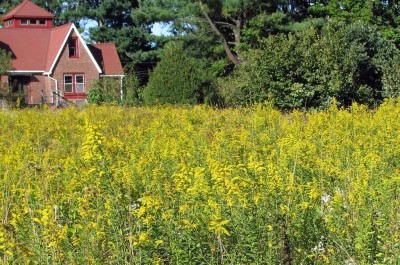 Goldenrod gets the blame for its showy, yellow blossoms during this allergy season. But the true culprit is ragweed, which goes unnoticed because it bears only small, green flowers.
Goldenrod gets the blame for its showy, yellow blossoms during this allergy season. But the true culprit is ragweed, which goes unnoticed because it bears only small, green flowers.
It makes sense that the pollen of a showy flower would not cause allergies. Showy flowers put on their show to attract insect (and, in some cases, bird or bat) pollinators. Wind can’t carry their heavy, sometimes sticky, pollen.
Pollen that causes allergies wafts around in the wind. Wind-pollinated flowers (euphoniously called “anemophilous” flowers) don’t need to attract animal pollinators.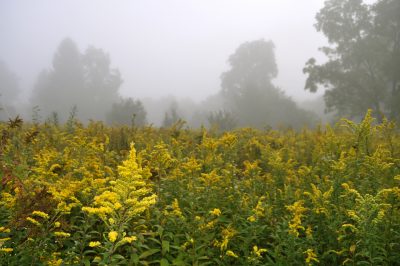
And Now, Enjoy the Flowers
With that said, I can safely revel in the rich golden yellow with which goldenrod’s flowers are painting sunny hillsides and fields this year. Goldenrod’s beauty comes as no surprise once you realize that it comes from a very good family, the Daisy Family, Asteraceae. Sunflower, black-eyed-Susan, coneflower — and thistles and dandelion — are among its kin.
Confirm goldenrod’s heritage with a magnifier trained on one of its small florets. Flowers in the Daisy Family are made up of one or both of two kinds of florets. Each disk floret is a relatively small, symmetrical tube of fused petals. Petals of the other kind of floret, ray floret, are also fused, but asymmetrically into one long, strap-shaped petal. The head of a sunflower (most varieties) is mostly disc florets circumscribed by prominently-petaled ray florets that create that decorative ring around the head. At the other extreme is a dandelion flower, all of whose florets are ray flowers, resulting in a powderpuff of yellow petals. Most species of goldenrod have flowers like those of sunflower — but you have to look closely. (For more about plant families, see my new book The Ever Curious Gardener: Using a Little Natural Science for a Lot Better Garden.)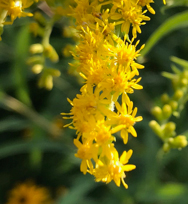
Meadow Reclamation
My meadow — or hayfield, or whatever you want to call it — was once replete with goldenrod. And before that, pale lilac flowers of wild bergamot (Monarda fistulas) blanketed much of the field. And before that, the field was grass, kept that way by the previous landowner’s regular mowing throughout the season.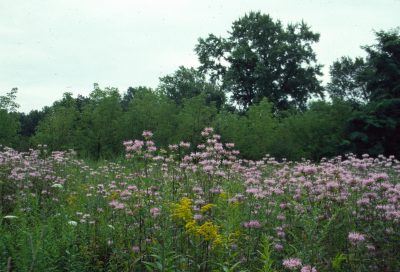
Sadly, for me, goldenrod has lost its prominence in my field, replaced by coarser and more woody plants such as poison ivy, sumac, and wild blackberries. My once-a-year mowing has kept these plants from totally getting control of the landscape. Without mowing, the field would, in time, become forest.
This spring, I decided to try to reclaim the field and, I hope, invite back some goldenrod and wild bergamot. My modus operandi is to mow regularly. In previous years, the wide paths I would mow and maintain mowed through one season would reflect that mowing for at least the following season or two or three. Mostly, it was the grasses, the only plants that can tolerate frequent mowing, that came into prominence.
I expect plants such as goldenrods and wild bergamot will gain footholds beginning next year and increasingly so in years to follow — until, of course, poison ivy and friends start to move in again.
Landscapes aren’t static, and changes come relatively quickly, not always predictably as the changes are seasoned with each year’s and more long term weather and climate patterns.
Wild Aromas, Cultivated Flavors
Wild grapes are also prominent in the wild landscape this year, mostly from the jasmine-like aroma with which they perfume the air. Here in eastern U.S. and Canada, fox grape (Vitis labrusca) is a prominent wild grape.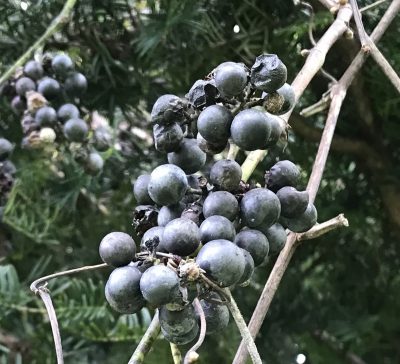
The variety Concord typifies the flavor and texture of fox grapes. Why “fox?” No one knows for sure, but around 1880, the botanist William Bartram suggested that the epithet was applied to this grape because of the “strong, rancid smell of its ripe fruit, very like the effluvia from the body of a fox.” Others suggested the epithet came about because foxes ate the grapes, or because the leaves resembled fox tracks.
Disease resistance and cold tolerance of fox grapes helped save the French wine industry a century and a half ago, when these grapes were hybridized with the traditional, disease-prone wine grapes (V. vinifera) of Europe. Thousands of hybrids now exist all along the spectrum from vinifera to fox as far as flavor, disease resistance, cold tolerance, and other characteristics.
I’m enjoying the aroma of the wild grapes but most appreciate the flavors of Vanessa, Somerset Seedless, Alden, Edelweiss, and my other cultivated varieties.
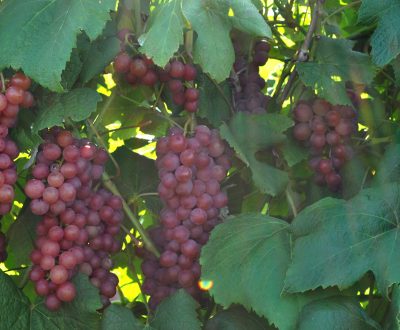
Vanessa grapes
Making My Bed(s); The “Best” Tomato
/13 Comments/in Gardening, Soil, Vegetables/by Lee ReichBuckwheat Beds
About a month ago the greenhouse was looking messy as oxalis, grasses, chickweed, and other weeds were starting to carpet the mostly bare ground. An unacceptable situation, considering that a month hence — now — I would need the space for planting in preparation for fall and winter.
The first step back in August was, obviously, to clear away the weeds, pulling almost each and every one out, roots and all. As long as weeds aren’t too overgrown or too abundant, the job is pleasantly satisfying. Moist soil also helps.
Pulling out weeds differs from the usual approach of preparing the soil by tilling it to discombobulate and bury weeds. I avoid tillage because it exposes buried weed seeds to light, which is just what new weeds need to germinate and grow. Tillage also burns up valuable humus and discombobulates not only the soil, but also resident fungi, earthworms, and other beneficial organisms.
I wasn’t ready to plant anything in some of those greenhouse beds a month ago, yet I hate to look at bare soil. (Mother Nature is equally repulsed by bare soil; she clothes it with weeds.) So I planted buckwheat, sprinkling the seeds thickly over the beds.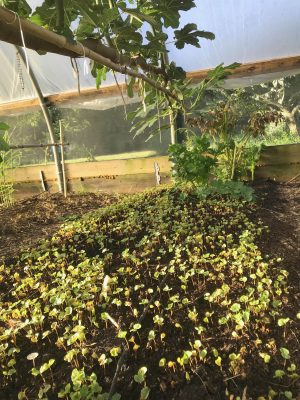 Buckwheat provides a quick and temporary cover of the bare ground. Sprinkling it with water assured its getting off to a quick start.
Buckwheat provides a quick and temporary cover of the bare ground. Sprinkling it with water assured its getting off to a quick start.
Finally, I covered the ground with an inch-thick layer of compost. That amount of compost will nourish whatever’s growing in the beds for a whole year. It also provides cover to hold moisture around the buckwheat.
Only a few days later, buckwheat sprouts were already peeking up through the compost blanket. They went on to grow quickly in the heat of the season. Aboveground the dense foliage was, I hoped, doing its job of shading out any new weeds trying sprout, something for which buckwheat is famous. 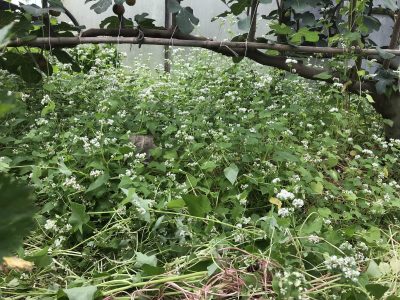 Below ground, the roots were latching onto nutrients that might otherwise leach away, bringing them up into the roots, stems, and leaves.
Below ground, the roots were latching onto nutrients that might otherwise leach away, bringing them up into the roots, stems, and leaves.
By the first week in September, buckwheat stems were flopping down onto the ground. Anyway, it was time to remove them to make way for planting the greenhouse. I was anxious to see what kind of new weed growth, if any, presented itself beneath the buckwheat.
The goal was to remove the buckwheat without disrupting the soil. My fingers easily raked off the tops which detached themselves from the roots that were left intact in the soil.
Buckwheat lived up to its reputation: I could hardly find a weed anywhere!
Oat Beds
Outdoor beds in the vegetable garden have been receiving similar treatment, with some wrinkles. Those beds that are finished for the season, not needed for autumn harvest, get cover crops of oats rather than buckwheat. Buckwheat doesn’t like cool weather and is killed by the slightest frost.
The advantage of oats over buckwheat is that oats enjoy cool weather, growing lush and green, and even tolerate quite a bit of cold weather. 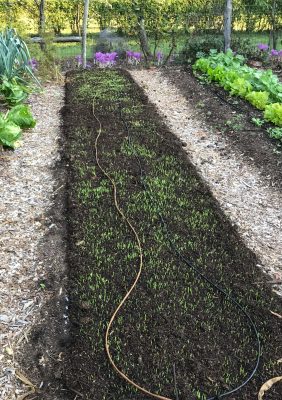 So any bed no longer needed for autumn vegetables and cleared before about the end of September gets oats (and compost). After the end of September, short days don’t provide enough light for the oats to grow enough to warrant planting.
So any bed no longer needed for autumn vegetables and cleared before about the end of September gets oats (and compost). After the end of September, short days don’t provide enough light for the oats to grow enough to warrant planting.
One benefit of oats, buckwheat, and any other cover crop is that they keep up appearances. 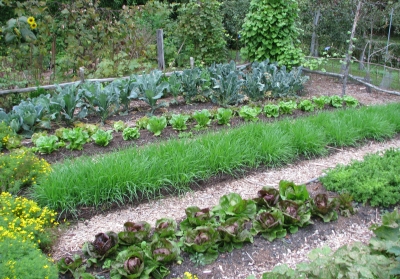 While I have great respect for soil, it’s not pretty to look at — and being bared isn’t good for the soil or the plants growing in it. I’d much rather look at a uniform, green carpet than bare, brown soil.
While I have great respect for soil, it’s not pretty to look at — and being bared isn’t good for the soil or the plants growing in it. I’d much rather look at a uniform, green carpet than bare, brown soil.
The Best(!!!!) Tomato
No need to rush summer vegetables out the door quite yet. I had the opportunity to try out a new tomato this season, Garden Gem, which has received a lot of fanfare.
Time travel back to 1995, when tomato breeder Harry Klee of the University of Florida, began to suss out what makes a great-tasting tomato using heirloom varieties, gas chromatography, and tasting panels. Then fast-forward to 2011, a field in Florida, where Harry tastes the result of his effort to breed a great-tasting tomato that is disease resistant and productive, and stands shipping. And so was born Garden Gem, the offspring of the luscious heirloom variety Maglia Rosa and the variety Fla. 8059, excellent in all characteristics except flavor.
Garden Gem scored as high as the heirloom parent for flavor.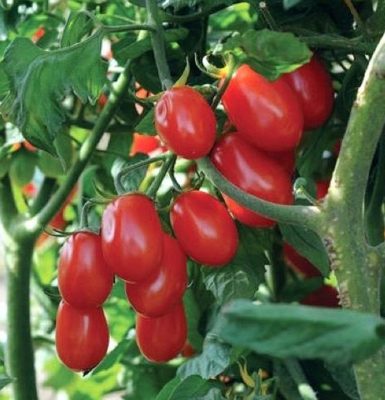 As it turns out, even taste is a matter of taste: To me, Garden Gem is not a great-tasting tomato; not even a good-tasting tomato. It lacked any sweetness or richness to smooth out the acidity, which is basically all I tasted.
As it turns out, even taste is a matter of taste: To me, Garden Gem is not a great-tasting tomato; not even a good-tasting tomato. It lacked any sweetness or richness to smooth out the acidity, which is basically all I tasted.
(The “perfect supermarket tomato,” as it was billed, was also a commercial flop, for now at least. It’s reported that Garden Gem too large for a small tomato and too small for a large tomato and, anyway, that consumers don’t really care about flavor.)
Some You Win, Some You Lose. Why?
/8 Comments/in Fruit, Pests, Soil, Vegetables/by Lee ReichMo’ Better Berries
Because I’ve grown a number of varieties of blueberries for a long time, I’m often asked what variety I would recommend planting. Or whether you need to plant two varieties for cross-pollination in order to get fruit.
The answers to both questions are intertwined. First of all, blueberries are partially self-fertile so one variety will bear fruit all by itself.
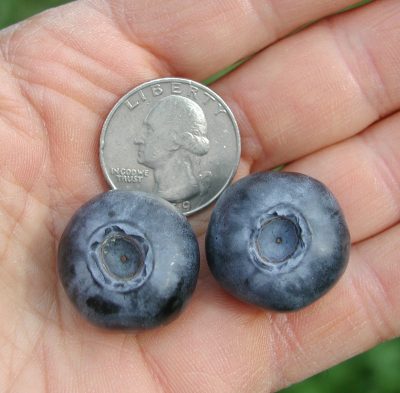
But — and this is important — berries will be both more plentiful and larger if two different varieties cross-pollinate each other. (Apples, in contrast, are self-sterile so, with few exceptions, won’t bear any fruit at all without cross-pollination.)
Benefits of cross-pollination aside, why plant just one variety of blueberry? Different varieties ripen their fruits at different times during the blueberry harvest season. With a good selection of varieties, that season can be very long.
Here on the farmden, the season opens with Duke and Earliblue, both usually ready for picking (in Zone 5) at the end of June. The season moves on, with Blueray, Berkeley, and Bluecrop ripening in July, and Jersey, Toro, and Nelson in August.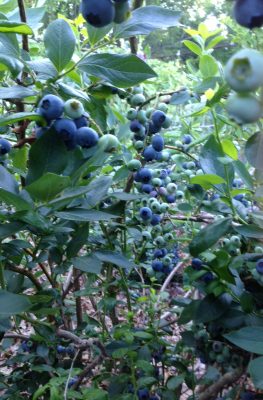 As I write, in September, the variety Elliot is still bearing ripe berries.
As I write, in September, the variety Elliot is still bearing ripe berries.
So if you’re going to plant blueberries, which I highly recommend doing, plant more than one variety, and choose the varieties that let you enjoy berries with your morning cereal or your after dinner ice cream over a long season.
Soil Matters
I pay special attention to the soil when I plant blueberries, and it pays off. Blueberries have rather unique soil requirements among cultivated plants, demanding those that are very acidic, high in organic matter, low in nutrients, and consistently moist and well-aerated. (Most cultivated plants like soils that are only slightly acidic and have moderate to high fertility.) No matter if a soil is not naturally to blueberry’s liking; it can be made so.
The soil where I planted my blueberries drains well. If it did not, I would either choose a better location or else create mounds on which to plant.
Next in importance is soil acidity; I test it before planting. If it’s not at the required pH of 4 to 5.5, I spread pelletized sulfur, a naturally mined mineral, over the ground. (Pelletizing the sulfur makes it less dusty to work with.) 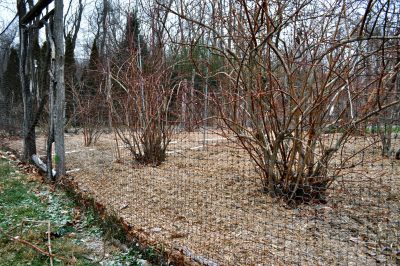
The amount of sulfur, per 100 square feet, needed to lower the pH by one unit would be a pound in a sandy soil and three pounds in a clay soil. My clay loam’s initial pH was about 6.5, so I needed 3 pounds of sulfur per hundred square feet to lower that pH to 5.5, that upper limit enjoyed by blueberries.
Now, for planting. I mix a bucketful of peat moss with the soil in each planting hole and then tuck the plants and soil into the hole, setting the plants slightly deeper than they stood in the nursery. Peat moss is a long-lasting source of organic matter, unique among organic matters in also being low in nutrients.
Right after planting, I spread a 2 to 3 inch depth of some weed-free, fluffy organic material, such as wood shavings, wood chips, straw, pine needles, or autumn leaves, as mulch. The mulch snuffs out weeds, which are more adept than blueberry at soaking up water and nutrients, and keeps the soil cool and moist, just as it is in blueberry’s natural habitats.
With regular watering, as needed, pruning, and annual mulching and attention to soil acidity, blueberry leaves should maintain a healthy, green color, and stems should grow a couple of feet or so each year. My planting of 16 plants yields almost 200 quarts per year of delicious, organic blueberries.
Celeriac Failure, Again
Blueberries have been a great success; now for a failure. Celeriac, a celery relative that puts that flavor into its softball-sized, white root, isn’t well-known as a vegetable, but I’d like to grow it. I’ve tried, for the past couple of years, without success. The problem is some sort of celery blight that kills the top growth so there’s no greenery to feed the root.
Both early blight and late blight, fungal diseases, could cause problems. They arrived in gardens on infected celery seed and/or infected celery debris from the previous cropping season. 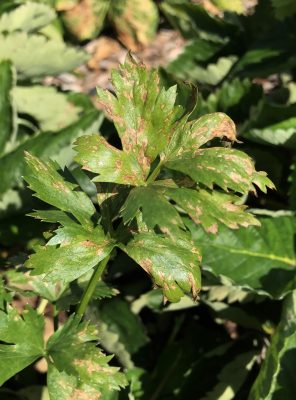 Last fall I thoroughly cleaned up diseased plants, even planted some celeriac this year in the greenhouse. Failure occurred both outdoors and in the greenhouse, although lots of rain and heat could have helped (the fungi or bacteria, not me).
Last fall I thoroughly cleaned up diseased plants, even planted some celeriac this year in the greenhouse. Failure occurred both outdoors and in the greenhouse, although lots of rain and heat could have helped (the fungi or bacteria, not me).
I’m not giving up. Perhaps the seed is the problem. Seed can harbor the disease, but can be “cleaned” up with a heat treatment: 30 minutes at 118°F. As a last resort, I could spray an organic fungicide such as one of the organically approved materials based on copper or hydrogen peroxide. Perhaps this time next year I’ll be eating celeriac.

